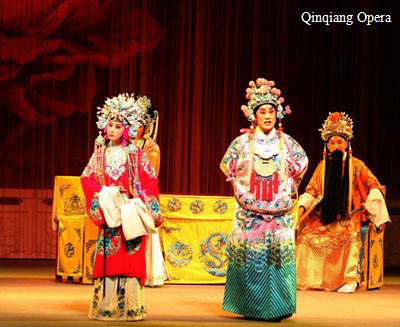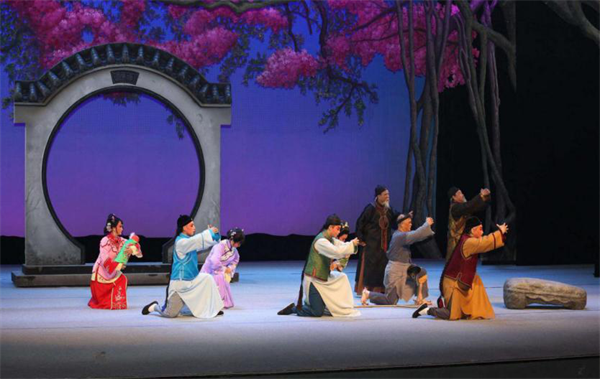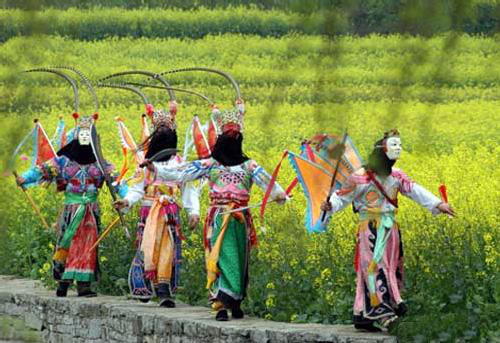- CURRENT LOCATION: HOME
- >> Tourism
- >> Travel Tips
- >>
- Entertainment
Entertainment in Shaanxi
2017-12-04 16:59:23 , Source : The Government Website of Shaanxi ProvinceAfter visiting the scenic spots and historical sites and tasting local snacks, you can appreciate entertainments in Shaanxi, such as the Tang Dynasty Music and Dance Show, Qinqiang Opera, Ansai Waist Drum Dance, and Xintianyou (a type of folk songs), and so on, to feel the glamour of Shaanxi from another angle.
Tang Dynasty Music and Dance Show

The Tang Dynasty Music and Dance Show refers to a group of excellent classical theatrical items created by the Shaanxi Singing and Dancing Troupe according to the cultural and artistic data on history, culture, poetry, musical dance, painting and murals of the Tang Dynasty after many years’ research, investigation and creation. The Tang Dynasty Music and Dance Show was the most representative musical dance of the Tang Dynasty, which displayed the prosperity of the Tang Dynasty and the happy life of the people. Since the first performance of the show in the 1980s, it has been performed in many parts of China and in the United States, Japan and countries in Southeast Asia, and has been well received by domestic and foreign audiences.
The Tang Dynasty Music and Dance Show is mainly performed at the Tang Dynasty, Xi’an, and Shaanxi Grand Opera House Xi’an.
Qinqiang Opera

Qinqiang is one of the oldest operas in China. In ancient times, Shaanxi was called Qin for short, hence the name. The tunes of Qinqiang are simple, vigorous, unadorned, as well as soft, gentle, light and lively. Its facial makeups are solemn, graceful, vivid and beautiful. The themes of Qinqiang Opera are extensive, and the plots are vivid. Accordingly Qinqiang Opera has been widely spread. Tan Dun, the composer for the opera The First Emperor, researched Qinqiang for the opera, in order to learn more about “ancient Chinese vocal styles”.
In Shaanxi, there are four types of Qinqiang according to different local dialects and pronunciations: Qinqiang in Tongzhou (present-day Dali area) in Guanzhong is called “Tongzhou Bangzi” (or Eastern Route Qinqiang); Qinqiang in Xi’an is called “Xi’an Luantan” (or Middle Route Qinqiang); Qinqiang in Fengxiang area is called “Xifu Qinqiang” (or Western Route Qinqiang); and Qinqiang in Hanzhong area is called “Handiao Huanghuang” (or Southern Route Qinqiang).
Ansai Waist Drum Dance

The Ansai Waist Drum Dance, with a history of more than 2,000 years, is a large folk dancing art peculiar to Shaanxi. It displays the unsophisticated and wild characters of the farmers on the Loess Plateau, revealing its unique artistic charm. Called the “No. 1 Drum Dance in the World”, the Ansai Waist Drum Dance can be performed by several people or by nearly 1,000 people, and the dance is an extremely impressive spectacle that consists of vigorous dances and leaps accompanied by frenetic drumming. The dance manifests vigorous movements to the accompaniment of rhythmic drumbeats. At the climax of the dance, dancers beat drums while jumping in the air and yelling: “Hai Hai”.
In 1996, Ansai County was named the “Hometown of the Chinese Waist Drum”. On May 20, 2006, the Ansai Waist Drum Dance was included in the first group of the National Intangible Cultural Heritage List with the approval of the State Council.
Xintianyou

Xintianyou is a type of folk song which is circulated in North Shaanxi. Its tunes are pure, simple, vigorous and long, and the rhymes are free. Usually a song is composed of two phrases; and two sentences of the lyric form a paragraph. The short songs have only one paragraph; and the long ones have several dozen paragraphs. Local artists sing a song with the same tune repeatedly. (Sometimes, the tune will be slightly changed.) The contents of the Xintianyou folk songs mainly reflect the people’s labor, life and love stories.
Handiaoerhuang

Handiaoerhuang is a local opera in South Shaanxi, developed from the folk songs and ditties spread far and wide in the Hanshui River valley. The tones show the pronunciation in Hanzhong area, similar to those of Handiao Opera in Hubei. The actors of Handiaoerhuang are good at performing civil plays, with a strong Sichuan flavor. The tunes are sweet; the dialogues are soft; the languages are humorous; the performance is exquisite; and the tunes and dialogues show heavy Sichuan pronunciation. Actors and actresses sing in two different tunes: the upper tunes and the lower tunes. The upper tunes are used to express the sorrowful, desolate and indignant feelings; and the lower tunes are used to express the smooth, comfortable, lively and bold emotion.
Shangluo Flower-Drum Opera

Shangluo Flower-Drum is a small local genre of drama loved by the people in the mountainous areas of Shangluo, and a folk art featuring singing and talking. The contents of the plays mainly reflect the local customs and the love stories between young men and women. “Jumping” and “dancing”, the most important characteristics in the performance of the Flower-Drum Opera, go through the whole performance.
The traditional Shangluo Flower-Drum Opera aria has a single musical structure and a long history. Therefore, it is regarded as the “living fossil” for studying the development and evolution of music and opera. On May 20, 2006, the Shangluo Flower-Drum was included in the first group of the National Intangible Cultural Heritage List with the approval of the State Council.
Duangong Opera

Duangong Opera is a small genre of drama, which was derived from the “sorcerer’s dance” in ancient times, and later developed into the folk musical drama. Duangong Opera usually performs short plays, which are performed by one actor and one actress to tell love stories. The tunes are simple, unadorned and soft; the form of expression is lively and free; and the libretto is humorous, with an unusually artistic style and strong local characteristics.

Government Organizations



Other Links

Copyright@www.shaanxi.gov.cn All Rights Reserved
Registration Number:陕ICP备10004160号
